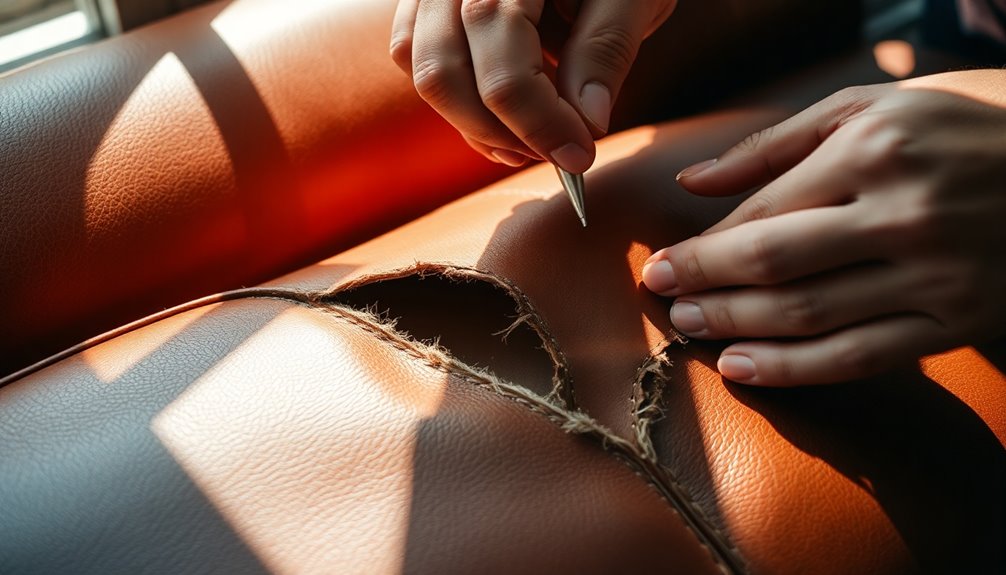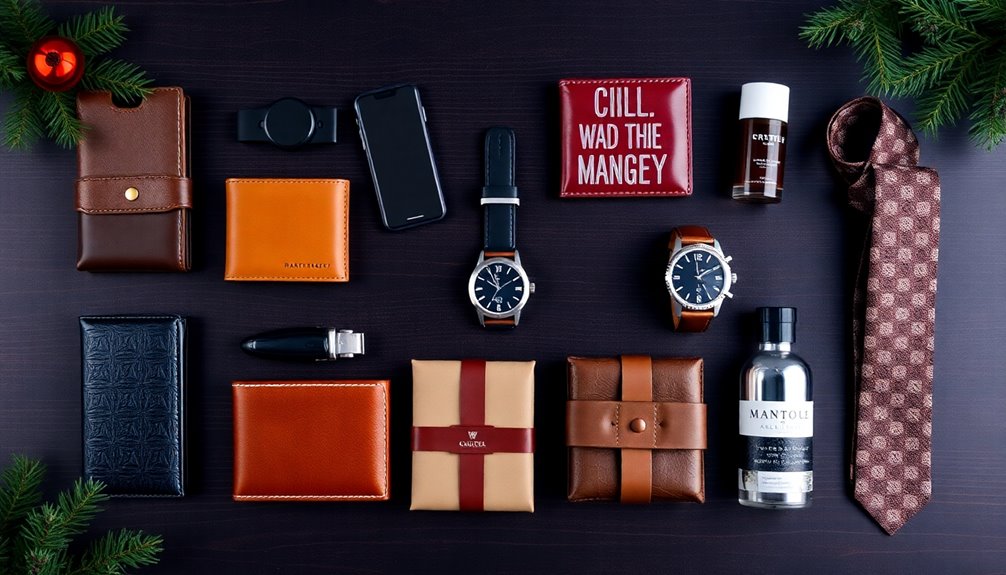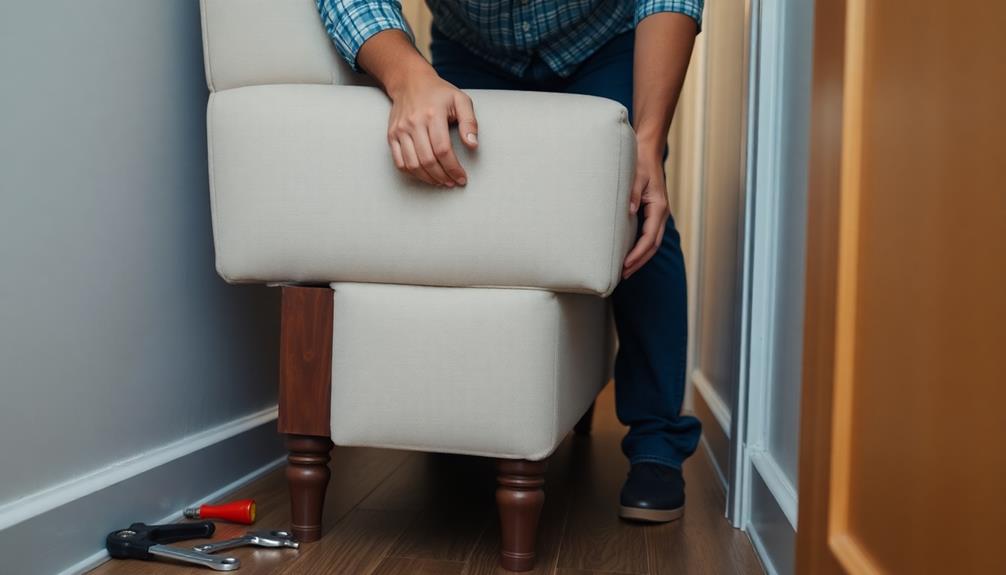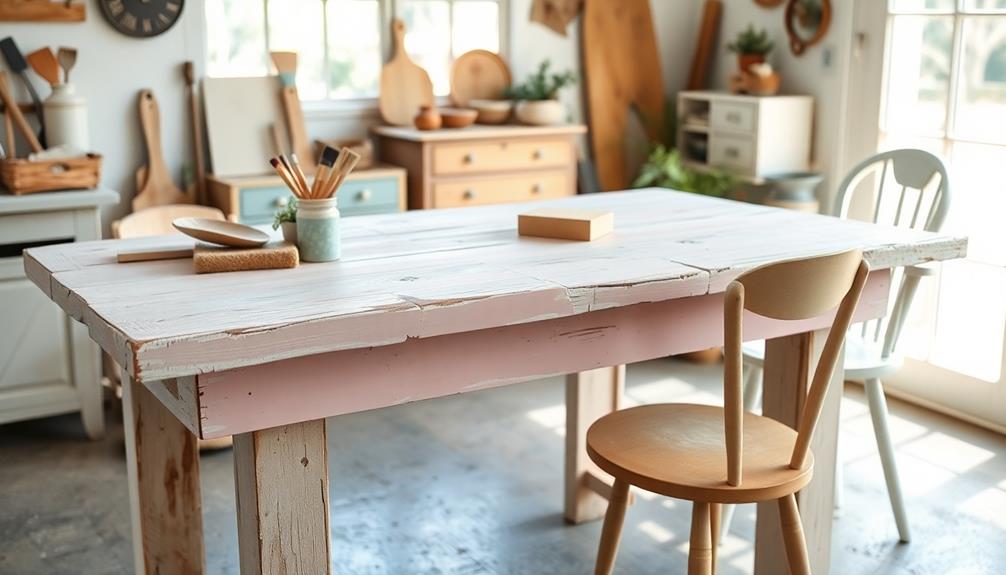To fix a torn leather sofa, start by cleaning the area with a damp cloth. Use a leather repair kit that includes color-matched dye and a repair cream for minor tears. Follow the kit instructions closely, applying the repair cream and allowing it to dry. For larger tears, you might need to use a patch and adhesive. Always test any products on an inconspicuous area first to ensure color match. After repairs, condition the leather to maintain its suppleness and prevent further damage. If you want to gather more tips on preserving your leather sofa, keep exploring. Additionally, regularly vacuuming your leather sofa can help remove dust and debris, preventing scratches and wear over time. It’s also important to avoid direct sunlight, as prolonged exposure can lead to fading and drying out of the material. For more comprehensive guidance on how to fix your leather sofa and keep it looking its best, consider consulting professional resources or tutorials that offer step-by-step advice.
Key Takeaways
- Inspect the tear to assess its size and determine if a repair kit is needed or if professional help is required.
- Use a leather repair kit that matches the color of your sofa for small tears, following the manufacturer's instructions carefully.
- Clean the torn area gently with a damp cloth to remove any dirt or oils before applying repair cream or adhesive.
- For deeper tears, use a backing fabric or leather patch to reinforce the area and then apply the repair product on top.
- After repairing, apply leather conditioner to restore suppleness and prevent further damage to the repaired area.
Introduction

Taking care of your leather sofa involves more than just fixing tears; it requires routine maintenance to keep it looking great. You'll want to use the right cleaning techniques and know how to treat specific stains, like wine spills. By staying proactive, you can extend your sofa's life and maintain its luxurious appearance.
Routine Leather Conditioning
To keep your leather sofa looking its best, you need to stay on top of routine leather conditioning. Performing this task every 6-12 months is crucial for maintaining the material's suppleness and preventing drying or cracking. Start by cleaning the leather surface with a damp cloth or a high-quality leather cleaner to remove dirt and grime. This step ensures better absorption of the conditioner.
Once the leather is clean, it's time to apply the conditioner. Use a soft cloth to spread the conditioner evenly, working it into the leather with circular motions. This technique promotes even distribution and helps restore moisture and flexibility, enhancing the overall appearance of your sofa. Remember to conduct a patch test on a small, inconspicuous area first. This precaution will help you avoid any discoloration or adverse reactions with your specific leather type.
In addition to routine conditioning, consider having a leather repair kit on hand for any unexpected damage. With regular care and the right products, your leather sofa will not only look great but also last for years to come.
Material-Specific Cleaning Techniques
While cleaning your leather sofa, it's essential to recognize that different materials require specific care techniques. For cleaning genuine leather, mix equal parts of diluted vinegar and water, or use a specialized leather cleaner. This method effectively removes dirt without damaging the material. Always test any cleaning product on a small, inconspicuous area first to ensure it won't cause discoloration or damage.
If your sofa is made of faux leather, opt for a gentle soap and water solution. Avoid harsher chemicals, as they can lead to peeling and deterioration of the synthetic surface. When cleaning, steer clear of sharp objects or abrasive materials, as they can scratch the leather and worsen any existing damage.
Regular maintenance is also key; conditioning genuine leather every 6-12 months keeps it supple and prevents cracking. If you notice any tears during your cleaning routine, consider using leather glue to mend them before they worsen. By understanding the specific needs of your leather materials, you can maintain the beauty and longevity of your sofa effectively.
Treating Wine Stains
Even with regular maintenance and careful cleaning, accidents like wine spills can happen. When you encounter a wine stain on your leather sofa, it's crucial to act quickly. Start by immediately blotting the area with a clean, dry cloth to absorb any excess liquid. Avoid rubbing, as this can push the stain deeper into the leather.
Next, mix a solution of equal parts water and white vinegar. Use a soft cloth to gently dab the stained area, which can help lift the stain without damaging the leather. If the stain proves stubborn, consider using a leather cleaner specifically formulated for treating wine stains. Always follow the manufacturer's instructions for the best results.
Before applying any cleaning solution, remember to test it on a small, inconspicuous area of the leather to ensure there's no discoloration or damage. Once you've successfully treated the stain, don't forget to apply a leather conditioner. This step is key to restoring moisture, maintaining suppleness, and preventing future damage. By following these steps, you can keep your leather sofa looking its best, even after an unexpected spill.
Avoiding Direct Sunlight Exposure
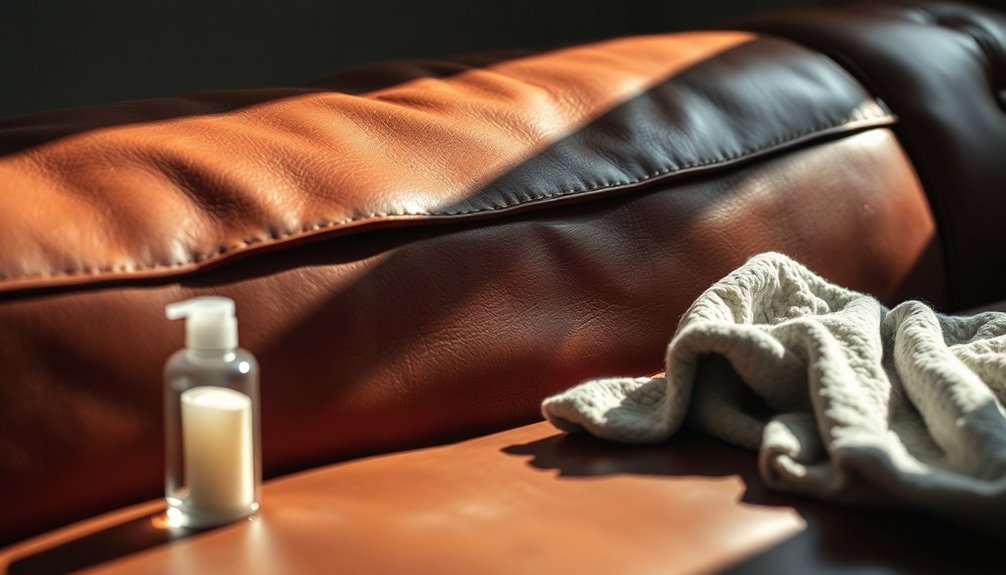
To keep your leather sofa looking its best, you'll want to avoid direct sunlight exposure. Consider placing scratching posts strategically to minimize wear, and protect your furniture with decorative throws. Regularly rotating your seating positions can also help prevent uneven fading and keep your sofa in top shape.
Scratching Post Placement
Proper placement of scratching posts can significantly protect your leather sofa from scratches and tears. Position these scratching posts strategically near your sofa to encourage your pets to use them instead of the furniture. This simple adjustment reduces the likelihood of damage to the leather surface. Ensure the scratching posts are tall enough—at least 28-36 inches—to attract your pets' natural scratching behavior.
While it's essential to place the scratching posts in a well-lit area, avoid direct sunlight exposure. This prevents your leather sofa from fading and drying out, maintaining its quality and appearance. Additionally, consider using a variety of materials for your scratching posts, such as sisal and cardboard. Different textures will appeal to your pets' unique scratching preferences, minimizing damage to the leather.
Regularly repositioning or adding new scratching posts can also help maintain your pet's interest. By keeping the scratching posts fresh and engaging, you effectively divert their scratching away from your leather furniture. With these strategies in place, you'll not only protect your leather sofa but also create a more enjoyable environment for your pets.
Protect With Decorative Throws
In addition to strategically placing scratching posts, using decorative throws can further protect your leather sofa from damage, especially from UV rays. These throws act as a barrier, preventing fading and cracking that direct sunlight can cause. By regularly incorporating throws into your decor, you not only enhance your living space but also shield the leather from pet scratches and spills, which minimizes repair needs and helps extend the lifespan of the sofa.
When selecting throws, opt for breathable, lightweight fabrics to maintain air circulation and reduce moisture buildup that could lead to mold or mildew. Coordinating the colors and patterns of the throws with your existing decor can create a stylish look while safeguarding the leather. Additionally, using protective throws can be a cost-effective strategy to avoid potential repair costs associated with sun damage, which can accumulate if not addressed promptly. So, start adding those throws to your leather furniture today, and enjoy both the aesthetic appeal and the protection they provide!
Regularly Rotate Seating Positions
Rotating your seating positions on a leather sofa not only helps distribute wear evenly but also plays a crucial role in protecting the furniture from damage caused by direct sunlight. By regularly switching where you sit, you can prevent specific areas from becoming excessively worn or damaged over time. This simple practice extends the life of your sofa.
Avoiding direct sunlight exposure is essential, as prolonged sunlight can lead to fading, drying, and cracking of the leather. To combat this, consider using curtains, blinds, or UV-protective window films to shield your sofa from harmful rays while maintaining your room's aesthetic appeal. Additionally, incorporating protective throws or covers on frequently used seating areas minimizes wear and tear, further safeguarding your furniture.
Establish a routine to inspect and rotate seating positions. This not only enhances the longevity of your leather sofa but also keeps it looking fresh and inviting. By understanding the importance of preventing wear and taking proactive measures, you'll ensure your leather furniture remains in excellent condition for years to come. So, make it a habit to rotate seating positions and protect your investment.
Routine Inspection and Touch-ups
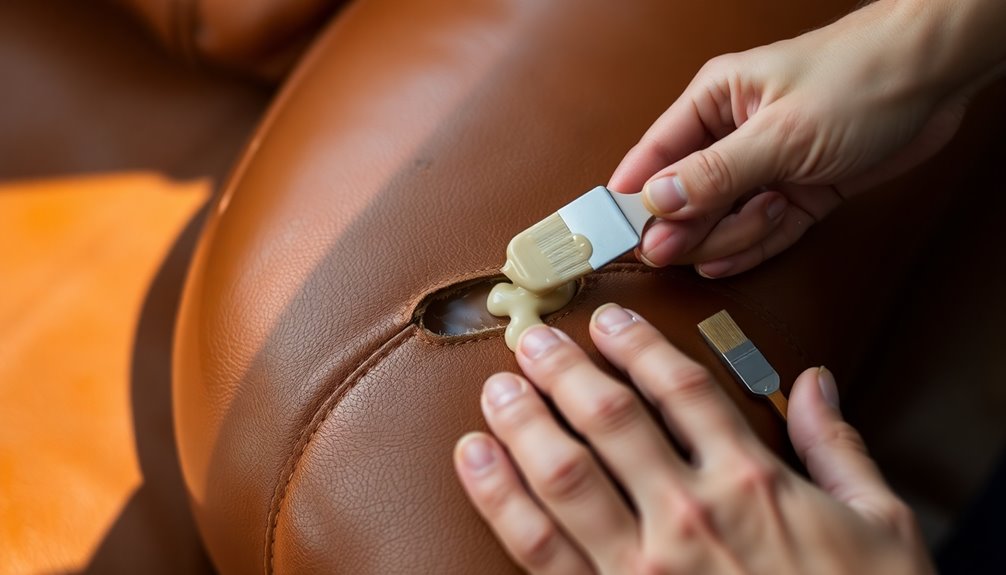
To keep your leather sofa in top shape, you should regularly check for any frame weaknesses or signs of wear. Addressing small issues early with leather repair techniques can save you time and money later on. Plus, routine touch-ups can revitalize the leather's appearance and extend its lifespan significantly.
Frame Weakness
Regular inspections of your leather sofa's frame are essential for maintaining its longevity and comfort. Start by checking for any signs of frame weakness, like creaking sounds or sagging seats. If you notice these issues, it's crucial to address them right away to prevent further damage.
Tighten any loose screws or bolts you find on the frame to ensure stability. This simple step can make a big difference in the overall support of your sofa. For joints that seem weak or loose, consider using wood glue to reinforce their structural integrity.
Don't forget to periodically check the cushions, too. If they're worn out, replacing them can alleviate additional stress on the frame, keeping it in better shape for longer.
Pay special attention to the stress points, such as corners and seams. Addressing any signs of wear in these areas will help prolong the life of both the leather upholstery and the frame. By staying proactive with these routine inspections and touch-ups, you'll be well on your way to effectively maintaining your leather sofa and avoiding costly repairs when it comes to repairing a leather couch.
Leather Repair Techniques
Inspecting your leather sofa for wear and tear is just the beginning of maintaining its condition. Regularly check for signs like small tears or cracks to catch issues early and prevent further damage. If you notice any imperfections, touch-ups can be performed using leather conditioner every 6-12 months. This helps maintain suppleness and prevents drying that may lead to tearing.
For minor scratches, you can apply a leather repair cream or color-matched leather dye to help blend these imperfections with the surrounding material. If you encounter small tears, consider using a leather repair kit, which typically includes patches, fillers, and dyes. Just be sure to follow the manufacturer's instructions for the best results.
Maintaining a clean leather surface is crucial, too. Using appropriate cleaners helps prevent dirt accumulation that may exacerbate wear and tear. By incorporating these inspection and touch-up techniques into your routine, you'll keep your leather sofa looking its best. With a little diligence and the right products, you can easily extend the life of your sofa and enjoy its beauty for years to come.
Revitalizing Leather Appearance
A consistent routine for revitalizing your leather sofa's appearance can make a significant difference in its longevity and aesthetic appeal. Start by conducting regular inspections to catch small tears or wear spots before they worsen. This proactive approach lets you address issues early, saving you time and effort down the line.
Every 6-12 months, applying leather conditioner is a good idea. This not only keeps the leather supple but also enhances its overall look, helping prevent future cracking or tearing. For any minor scratches or discoloration, touch-ups with leather paint or filler can effectively conceal imperfections, ensuring your sofa maintains a consistent and polished appearance.
Additionally, using coasters and protective covers minimizes the risk of stains and scratches, preserving the leather's beauty over time. If spills occur, promptly attending to them with the appropriate cleaning methods can prevent permanent damage. By following these steps, you can keep your leather sofa looking fresh and inviting for years to come. Remember, regular maintenance is key to a stunning and long-lasting piece of furniture.
Personalized Leather Color Matching
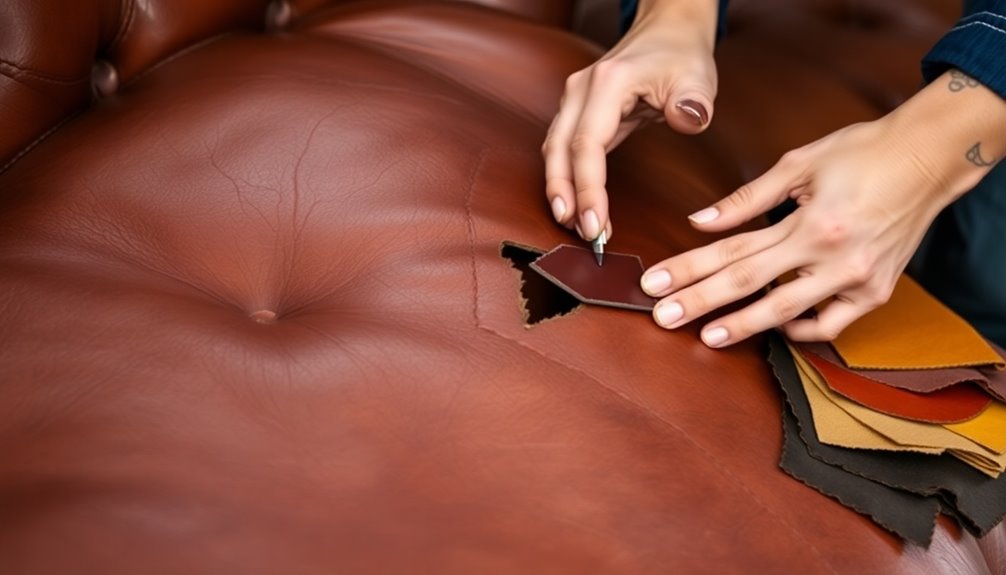
Finding the right color match for your leather sofa can make all the difference in achieving a flawless repair. Personalized leather color matching is essential for ensuring that any touch-ups blend seamlessly with your existing leather. Start by obtaining a sample of your original leather, as variations in dye and texture can affect the final result. This sample will guide you in choosing the correct shade.
Most leather repair kits come equipped with color-matching solutions designed to help you find the perfect hue. Before applying any paint, always test the color on an inconspicuous area to confirm it matches the surrounding leather. This step is crucial, as it saves you from potential mismatches that could ruin your repair.
If you're unsure about your matching skills, consider consulting a leather repair professional. They often utilize advanced color-matching tools and databases to identify the exact shade and finish of your leather. Additionally, regular conditioning of your leather can help maintain its color over time, making it easier to match during repairs. With the right approach, you'll achieve a seamless and professional-looking repair for your leather sofa.
Seasonal Leather Storage Tips

When it comes to protecting your leather sofa during seasonal storage, taking the right steps is crucial for maintaining its quality. Start by cleaning your sofa thoroughly with a leather cleaner or a vinegar-water solution. This will remove dirt and oils that could cause damage over time. After cleaning, apply a high-quality leather conditioner. This helps keep the material supple and prevents it from drying out or developing cracks and tears in leather during storage.
Next, ensure you store your leather furniture in a climate-controlled environment. Avoid areas with extreme temperatures or high humidity, as these conditions can lead to mold, mildew, and other forms of damage. To further protect your sofa, use breathable protective covers. These will shield your leather from dust and potential scratches while allowing moisture to escape.
Lastly, regularly inspect your stored leather items for signs of damage or pests. Address any issues promptly to maintain their condition and longevity. By following these seasonal leather storage tips, you can ensure your leather sofa remains in excellent shape, ready to be enjoyed when the season returns.
Conclusion
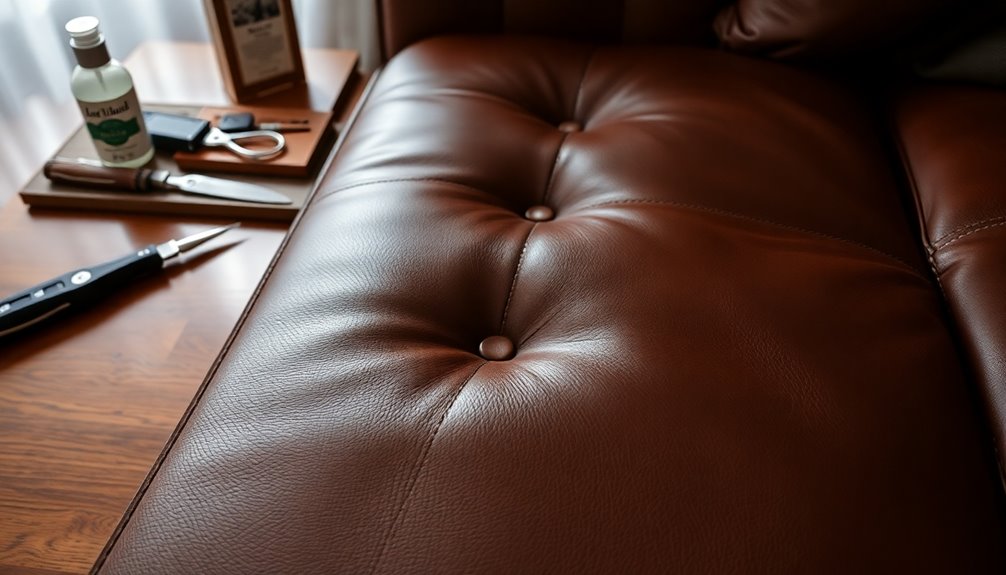
Successfully fixing a torn leather sofa not only restores its appearance but also enhances its longevity. If you tackle minor tears yourself, you'll find that using leather glue or even super glue is often the best option. Just remember to clean the area with a vinegar-water solution before diving into any repairs. For small tears, apply the glue and pinch the edges together to form a strong bond. Larger tears may need a denim patch for extra support, along with some filling.
After you've made the repairs, color-matching with leather paint is essential to ensure your sofa looks seamless. Don't forget to apply a leather conditioner afterward; this step helps maintain the leather's suppleness and protects against future damage.
Regular maintenance is key to prolonging the life of your sofa. Conditioning every 6-12 months and promptly addressing new damage can prevent future tears. By following these steps, you can effectively restore your leather sofa and enjoy it for years to come. With a bit of effort and the right materials, you can keep your sofa looking its best and feeling comfortable.
Frequently Asked Questions
Can a Ripped Leather Sofa Be Repaired?
Yes, a ripped leather sofa can definitely be repaired. You can choose from various methods, like using leather glue for minor tears or applying patches for added support. For larger damages, specialized repair kits are available, or you might opt for professional help if the damage is extensive. Remember, knowing your leather type is crucial to ensure the right repair approach. Regular maintenance can also prevent future tears and keep your sofa looking great.
Can Torn Leather Be Repaired?
Yes, torn leather can be repaired effectively. For small tears, you can use leather glue and reinforcing patches from a repair kit. If the damage is more extensive, it's best to consult a professional for seamless restoration. Regular maintenance, like conditioning and cleaning, helps prevent future tears. Identifying the type of leather you have is crucial, as repair methods vary significantly between pure leather and bonded leather.
Is It Worth Repairing a Leather Couch?
You'll find that repairing a leather couch can be worth it, especially if the repair costs are much lower than replacing it. If your couch holds sentimental value or is high-quality, professional repairs can extend its life. For minor tears, DIY kits are budget-friendly and effective. Regular maintenance can help retain your couch's value, too, so consider the type of leather before deciding whether to invest in repairs or not.
Do Leather Repair Kits Actually Work?
Yes, leather repair kits can work quite well for minor tears and scratches. Many users have found success when they carefully follow the instructions and prepare the area beforehand. The effectiveness may vary depending on the type of leather, with pure leather typically yielding better results than bonded or faux options. Always test a small, hidden spot first to ensure compatibility before tackling larger repairs. With patience, you'll likely achieve a smooth finish.
